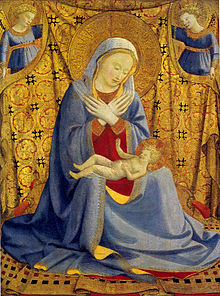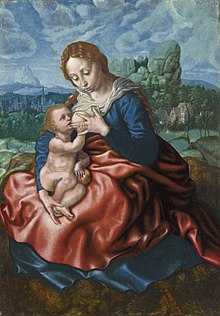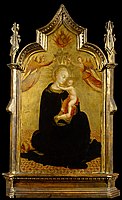
A Madonna of humility or Virgin of humility is a depiction in art of the Virgin Mary sitting on the ground, or upon a low cushion. She usually holds the Christ Child in her lap, making it one form of the Madonna and Child. The iconography originated in the 14th century, and was most common in that and the following century.
Initially mostly using a gold ground style, when painted backgrounds came to be preferred in the 15th century, this pose is very common in images of the Virgin in a hortus conclusus or "enclosed garden", where the Virgin often sits on the flowery grass.
History and development
Humility is a virtue extolled by Saint Francis of Assisi, and this iconography was associated with Franciscan piety, although it was not the creation of the Franciscans, since the artist first associated with the image, Simone Martini, had ties with the Dominicans and may have created the image for them. The word humility derives from the Latin humus, meaning earth or ground.
The earliest known painting of this type dates to 1346 and is at the Museo Nazionale in Palermo. It represents a Madonna seated on a small cushion just above the ground. The Christ Child partially looks at the viewer. The painting bears the inscription Nostra Domina de Humilitate, with the low cushion intended to express her humility. This painting in Palermo is, however, of a somewhat mediocre quality and was perhaps based on a work of Simone Martini. A similar painting in the Gemäldegalerie, Berlin, and both paintings were probably based on a Madonna of humility by Martini. A Virgin of humility fresco by Simone Martini survives in the Palais des Papes in Avignon, France.
An altar was dedicated to the Madonna of humility in the church of Santa Maria Novella in Florence in 1361. This style of painting spread quickly through Italy and by 1375 examples began to appear in Spain, France and Germany. It was the most popular among the depictions of the early Trecento artistic period.
Examples

Domenico di Bartolo's Madonna of Humility, painted in 1433, was described by art historian Andrew Ladis as one of the most innovative devotional images of the early Renaissance. The formal symmetry of the strips below her feet and those hovering above her symbolize the harmony of her human nature and status as an earthly woman, with her heavenly queenship. Despite the low seating position, the star and the gems as well as the halo signify her regal status. In this painting, which is at the Pinoteca Nazionale in Siena, Domenico did not use cast shadows as he did in other works such as the Madonna Enthroned.
Filippo Lippi's Madonna of Humility, painted between 1431 and 1437, is also an important work and illustrates Lippi's early style, when he was attentive to Masaccio's use of large and round figures. It was painted during a period when Lippi had dropped out of sight, and had perhaps gone into exile with Cosimo de' Medici.
A miracle attributed to the fresco of the Madonna of Humility painted in circa 1370 gave rise to the construction of the Basilica of Our Lady of Humility in Pistoia, Tuscany, Italy. The fresco is sometimes attributed to Giovanni di Bartolomeo Cristiani, but was perhaps done by a local painter from Pistoia. The Basilica, built by architect Ventura Vitoni, is an important example of high Renaissance architecture. Giorgio Vasari built the octagonal dome atop the Basilica in 1562. The original fresco remains within the Basilica.
Other key examples include Bernardo Daddi's central panel in the De Carlo Triptych in which the Madonna is shown sitting in a very low chair, rather than on a cushion. Fra Angelico's representation of about 1430 (which includes two angels) is notable in that Jesus is approached from above, focusing on his divinity. Giovanni di Paolo's depiction of about 1456 (see gallery below) represents a transition in the perception of nature, with the visual landscape forming itself around the seated Madonna.
Feast

The feast of the Humility of the Blessed Virgin Mary was on July 17. It was included in the General Roman Calendar of 1954 among the feasts pro aliquibus locis (in some places), but was removed from the General Roman Calendar of 1960.
Upon the election of Pope Francis in 2013, Russian Orthodox Bishop Hilarion Alfeyev gifted an icon of Our Lady of Humility, which the Roman Pontiff accepted; then donated to Pope Emeritus Benedict XVI during their farewell meeting at Castel Gandolfo.
Gallery
-
 Fra Angelico, c. 1430.
Fra Angelico, c. 1430.
-
 Lorenzo Monaco, c. 1410
Lorenzo Monaco, c. 1410
-
 Donatello, low relief in marble, 1420s
Donatello, low relief in marble, 1420s
-
 Sano di Pietro c. 1440
Sano di Pietro c. 1440
-
 Andrea di Bartolo, c. 1410
Andrea di Bartolo, c. 1410
-
 Sassetta, ca. 1445–1450
Sassetta, ca. 1445–1450
-
 After Robert Campin, set in a hortus conclusus
After Robert Campin, set in a hortus conclusus
-
 Giovanni di Paolo, c. 1456
Giovanni di Paolo, c. 1456
See also
References
| Part of a series on the |
| Mariology of the Catholic Church |
|---|
 Immaculate Conception by Bartolomé Esteban Murillo (c. 1675) Immaculate Conception by Bartolomé Esteban Murillo (c. 1675) |
| Overview |
| Titles of Mary |
| Prayers and hymns |
| Devotional practices |
Movements and societies
|
| Apparitions |
Key Marian feast days
|
|
|
- Renaissance art: a topical dictionary by Irene Earls 1987 ISBN 0-313-24658-0 page 174
- Williamson, Beth (2009). The Madonna of Humility. Boydell and Brewer. p. 115.
- A history of ideas and images in Italian art by James Hall 1983 ISBN 0-06-433317-5 page 223
- Iconography of Christian Art by Gertrud Schiller, 1971 ASIN: B0023VMZMA page 112
- Cat. # 1072, Follower of Lippo Memmi per the 1986 catalogue.
- ^ Painting in Florence and Siena after the Black Death by Millard Meiss 1979 ISBN 0-691-00312-2 pages 132–133
- Provence, 4th by Dana Facaros, Michael Pauls 2004 ISBN 1-86011-175-0 page 94
- Painting in Florence and Siena after the Black Death by Millard Meiss 1979 ISBN 0-691-00312-2 page 144
- ^ Art and music in the early modern period by Franca Trinchieri Camiz, Katherine A. McIver ISBN 0-7546-0689-9 page 15
- Sassetta: the Borgo San Sepolcro altarpiece, Volume by James R. Banker, Machtelt Israėls 2009 ISBN 0-674-03523-2 page 309
- Humanists and Reformers: A History of the Renaissance and Reformation by Bard Thompson 1996 ISBN 0-8028-6348-5 page 249
- Painting in Florence and Siena after the Black Death by Millard Meiss 1979 ISBN 0-691-00312-2 pages 136
- The Christian Travelers Guide to Italy by David Bershad, Carolina Mangone, Irving Hexham 2001 ISBN 0-310-22573-6 page
- The fourteenth century. Bernardo Daddi and his circle by Richard Offner, Miklós Boskovits 2002 ISBN 88-09-02182-7 page 21
- Jesus of History, Christ of Faith by Thomas Zanzig 2000 ISBN 0-88489-530-0 page 306
- Man in the Landscape: A Historic View of the Esthetics of Nature by Paul Shepard, Dave Foreman 2002 ISBN 0-8203-2440-X page 170
- "July 17th: Humility of the Blessed Virgin Mary". Retrieved July 17, 2021.
- Peterson, Larry (July 27, 2018). "The Humility of the Blessed Virgin Mary; This was Her defining Virtue". Catholic 365. Retrieved July 17, 2021.
- Lovasik, S.V.D., Rev. Lawrence G. "Our Lady's Feast Days". EWTN. Retrieved July 17, 2021.
- Rembrandt's faith by Shelley Karen Perlove, Larry Silver 2009 ISBN 0-271-03406-8 page 175
Further reading
- Williamson, Beth, Madonna of Humility: Development, Dissemination and Reception, c. 1340–1400 (Woodbridge, Suffolk: Boydell Press, 2009) (Bristol Studies in Medieval Cultures, 1).